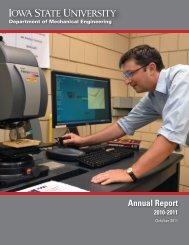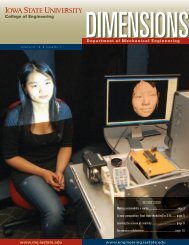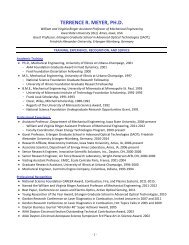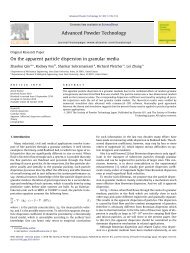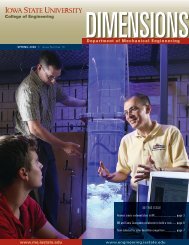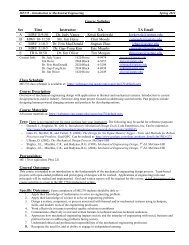Consider-then-Choose Models in Decision-Based Design ...
Consider-then-Choose Models in Decision-Based Design ...
Consider-then-Choose Models in Decision-Based Design ...
Create successful ePaper yourself
Turn your PDF publications into a flip-book with our unique Google optimized e-Paper software.
Lemma 2. If (ω,X,p) is feasible for Eqn. (15), <strong>then</strong> ω is almost<br />
choice-consistent with (X,p).<br />
Note, however, that some choice-<strong>in</strong>consistent ω’s are feasible<br />
for Eqn. (15), because the constra<strong>in</strong>ts allow ω i, j,r = 0 when<br />
s i,r (x j , p j ) = 0.<br />
Eqn. (15) is a relaxation of Eqn. (9) <strong>in</strong> the follow<strong>in</strong>g sense:<br />
Lemma 3. ˆπ B,∗ ≥ π C,∗ where ˆπ B,∗ is the optimal value of Eqn.<br />
(15) and π C,∗ is the optimal value of Eqn. (9). Moreover, if<br />
(ω,X,p) is a local solution of Eqn. (15) and ω is strictly choiceconsistent<br />
with (X,p), <strong>then</strong> (X,p) is a local solution to Eqn. (9).<br />
The relationship between Eqn. (15) and Eqn. (9) is analogous to<br />
LP relaxations of ILPs: An <strong>in</strong>teger solution to the LP is a solution<br />
to the ILP, but solutions to the ILP are not always solutions to<br />
the relaxed LP [42]. ILP strategies that use LP relaxations solve<br />
the relaxations and <strong>then</strong> add constra<strong>in</strong>ts to progressively enforce<br />
<strong>in</strong>tegrality <strong>in</strong> the LP solution.<br />
Branch-and-Bound (B&B) heuristics may be an appropriate<br />
solution strategy because the b<strong>in</strong>ary variables <strong>in</strong> Eqn. (15) are<br />
not “categorical” [43] and thus Eqn. (15) admits cont<strong>in</strong>uous relaxations.<br />
(Note that because Eqn. (15) is non-convex, B&B<br />
techniques are global optimization heuristics [40].) One potential<br />
difficulty with this approach could be the result<strong>in</strong>g problem<br />
size: there are J ∑ I i=1 R i new variables and 2J ∑ I i=1 R i new <strong>in</strong>equality<br />
constra<strong>in</strong>ts that form this relaxation, even before <strong>in</strong>clud<strong>in</strong>g<br />
constra<strong>in</strong>ts that would be added to force the ω’s <strong>in</strong>to {0,1}.<br />
Moreover, the cont<strong>in</strong>uous relaxations for Eqn. (15) will, implicitly,<br />
have complementarity constra<strong>in</strong>ts [44]: if ω i, j,r ∈ [0,1], <strong>then</strong><br />
the constra<strong>in</strong>ts ω i, j,r s i,r (x j , p j ) ≤ 0 and (1−ω i, j,r )s i,r (x j , p j ) ≥ 0<br />
mean that<br />
s i,r (x j , p j ) < 0 ⇐⇒ ω i, j,r = 1<br />
s i,r (x j , p j ) = 0 =⇒ ω i, j,r ∈ [0,1]<br />
s i,r (x j , p j ) > 0 ⇐⇒ ω i, j,r = 0<br />
These relations are commonly called a “Mixed Complementarity<br />
Problem” (MCP) and denoted by 0 ≤ ω i, j,r ≤ 1 ⊥ s i,r (x j , p j ) [45–<br />
49]. Mathematical Programs with Complementarity Constra<strong>in</strong>ts<br />
(MPCCs) are challeng<strong>in</strong>g mathematical programs, as discussed<br />
further below <strong>in</strong> Section 5. Exist<strong>in</strong>g Branch & Bound techniques<br />
for solv<strong>in</strong>g Eqn. (15) will have difficulties with the underly<strong>in</strong>g<br />
NLPs without special treatment of the implicit complementarity<br />
constra<strong>in</strong>ts <strong>in</strong> the cont<strong>in</strong>uous relaxations of Eqn. (15).<br />
An Explicit MPCC Relaxation<br />
Because complementarity constra<strong>in</strong>ts must be addressed to<br />
solve Eqn. (15), we must <strong>in</strong>vestigate the associated MPCC:<br />
maximize<br />
with respect to<br />
subject to<br />
ˆπ C (ω,X,p)<br />
ω i, j,r ∈ [0,1] for all i, j,r<br />
l j ≤ x j ≤ u j , p j ≥ 0 for all j<br />
c E j (x j ) = 0, c I j(x j ) ≤ 0 for all j<br />
0 ≤ ω i, j,r ≤ 1 ⊥ s i,r (x j , p j )<br />
for all i, j,r<br />
(16)<br />
Eqn. (16) is the cont<strong>in</strong>uous relaxation of Eqn. (15) before constra<strong>in</strong>ts<br />
are added to force the ω’s to take b<strong>in</strong>ary values. Be<strong>in</strong>g<br />
able to efficiently solve Eqn. (16) may be considered a prerequisite<br />
to efficiently solv<strong>in</strong>g Eqn. (15).<br />
Like Eqn. (15), Eqn. (16) has the follow<strong>in</strong>g properties:<br />
Lemma 4. If (ω,X,p) is feasible for Eqn. (16), <strong>then</strong> ω is almost<br />
choice-consistent with (X,p).<br />
Lemma 5. ˆπ CC,∗ ≥ π C,∗ where ˆπ CC,∗ is the optimal value of<br />
Eqn. (16) and π C,∗ is the optimal value of Eqn. (9). Moreover,<br />
if (ω,X,p) is a local solution of Eqn. (16) and ω is strictly<br />
choice-consistent with (X,p), <strong>then</strong> (X,p) is a local solution to<br />
Eqn. (9).<br />
Directly solv<strong>in</strong>g Eqn. (16) may avoid the need to enforce<br />
<strong>in</strong>tegrality with B&B techniques. However, B&B techniques<br />
will probably encourage convergence to global optima, and thus<br />
should be considered if the MPCC relaxation can be solved reliably<br />
and efficiently.<br />
5 SOLVING MPCC RELAXATIONS<br />
MPCCs are hard NLPs largely because standard constra<strong>in</strong>t<br />
qualifications fail to hold at any feasible po<strong>in</strong>t [44]. Specifically,<br />
the active constra<strong>in</strong>t gradients (<strong>in</strong>clud<strong>in</strong>g bounds) cannot be l<strong>in</strong>early<br />
<strong>in</strong>dependent at any feasible po<strong>in</strong>t. This property can be<br />
easily seen <strong>in</strong> the NLP form of the MPCC relaxation for our simple<br />
example, Eqn. (??) below. Related problems are that the<br />
feasible region may not have a topological <strong>in</strong>terior, mak<strong>in</strong>g convergence<br />
difficult for IP methods, and that local l<strong>in</strong>earizations<br />
may be <strong>in</strong>consistent, mak<strong>in</strong>g convergence difficult for SQP methods<br />
[50, 51].<br />
Solv<strong>in</strong>g MPCCs as NLPs<br />
The mathematical programm<strong>in</strong>g literature has dealt with<br />
many of these challenges, and identified the appropriate ways<br />
<strong>in</strong> which standard NLP solvers can be used to solve MPCCs;<br />
see, e.g., [50, 51] or the review <strong>in</strong> [44]. IP methods can be used<br />
8 Copyright c○ 2012 by ASME




